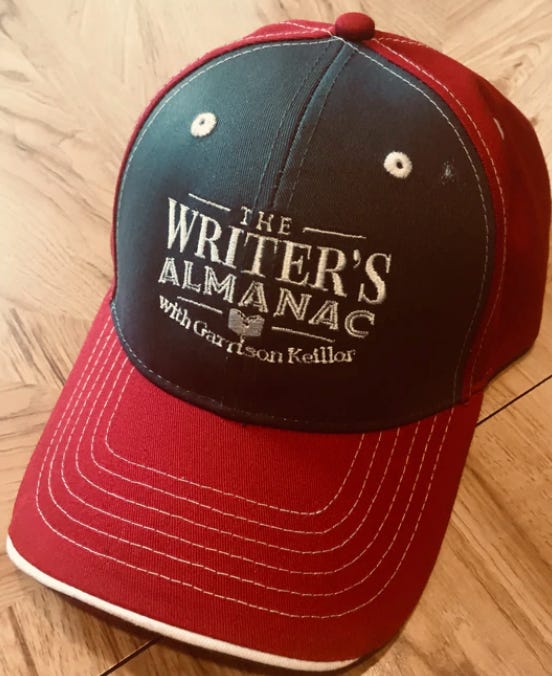“From June to December Summer Villanelle” by Wendy Cope from Making Cocoa for Kingsley Amis. © Faber & Faber, 1986.
ORIGINAL TEXT AND AUDIO - 2016
Today is the birthday of architect Frank Lloyd Wright, born in Richland Center, Wisconsin (1867). His life spanned an era full of dramatic changes: he was born two years after the Civil War ended, and died in 1959, a year and a half after the first Sputnik launch.
His first professional mentor was architect Louis Sullivan. Sullivan coined the saying “form follows function,” and he believed that American architecture should have its own unique qualities and not simply try to replicate old European standards. Sullivan’s philosophy greatly influenced Wright, who took it one step further with his own theory that form and function should be one. His simple, clean designs inspired the Prairie School architects, and “Taliesin,” his Wisconsin home, was the perfect example of the Prairie Style. When it came to designing homes on commission, he always claimed that the clients’ wishes came first — but was plainly of the opinion that his clients didn’t really know what they wanted. “It’s their duty to understand, to appreciate, and conform insofar as possible to the idea of the house,” he once said.
Wright would often tell his students: “Study nature, love nature, stay close to nature. It will never fail you.” His aim was to design buildings that complemented — even seemed part of — nature. He used building materials like wood and stone, and never painted them. His designs were horizontal, with low rooflines, so that the buildings blended in with the landscape as much as possible. He incorporated walls made almost entirely of windows, to blur the line between the outdoors and the indoors. The glass walls were also functional, using winter sunlight to help heat the house. “No house should ever be on a hill or on anything,” he said. “It should be of the hill. Belonging to it. Hill and house should live together each the happier for the other.” Even when he designed skyscrapers and other urban buildings, he always tried to incorporate elements inspired by natural structures. One of the most famous of these is New York’s Solomon R. Guggenheim Museum, which resembles a giant white snail shell.
It's the birthday of the editor who ushered in the Golden Age of Science Fiction: John W. Campbell , born in Newark, New Jersey (1910). His father was an electrical engineer, and Campbell was interested in science from the time he was a kid. He started writing science fiction when he was 18, a student at the Massachusetts Institute of Technology, and published his first story a year later.
He wrote under his own name and a pseudonym, Don A. Stuart. His work includes the novella Who Goes There? (1938), about a group of researchers in Antarctica who discover an alien buried in the ice. The alien has the ability to inhabit the body of anyone it attacks, to such a convincing degree that it is impossible for the researchers to recognize which of them are still themselves and which are now aliens. It was made into the film The Thing From Another World (1951), its remake The Thing (1982), and later this year, a prequel, also called The Thing.
John Campbell's most lasting contributions to science fiction came from his role as an editor. In 1937, the editor of the science fiction magazine Astounding Stories retired and hired Campbell to replace him. Campbell immediately changed the name to Astounding Science-Fiction (and later to Analog), and he transformed the magazine. He wanted to change its reputation from that of a pulp fiction publication to one based on real science. He recruited and championed writers like Isaac Asimov, A.E. van Vogt, Robert A. Heinlein, and Theodore Sturgeon. He demanded that the stories he publish have convincing science as well as convincing characters. He preferred uncomfortable ideas that would push readers, and he had no qualms insisting that his writers completely change the endings of stories if he didn't like them. Isaac Asimov said, "What he wanted were people who would write stories in which the science was realistic. Not realistic in the sense that they couldn't go out into the blue yonder, not realistic in the sense that they couldn't extrapolate wildly, but realistic in the sense that people who worked in science resembled people who actually worked in science. That scientists acted the way scientists do, that engineers acted the way engineers do — and in short, that the scientific culture be represented accurately."
Asimov said of Campbell: "When I first met him I thought of him as ageless. He was a tall, large man with light hair, a beaky nose, a wide face with thin lips, and with a cigarette in a holder forever clamped between his teeth. He was talkative, opinionated, quicksilver-minded, overbearing. Talking to him meant listening to a monologue. Some writers could not endure it and avoided him, but he reminded me of my father, so I was perfectly willing to listen to him indefinitely."
Be well, do good work, and keep in touch.®
****************************************
THE WRITER’S ALMANAC new TWO-TONED BASEBALL CAP $24.00
TO PURCHASE - CLICK





yes..how can we get the poetry back?.. that was the top feature. I must have copied poems from years now on the almanac
How can I get the poetry again?